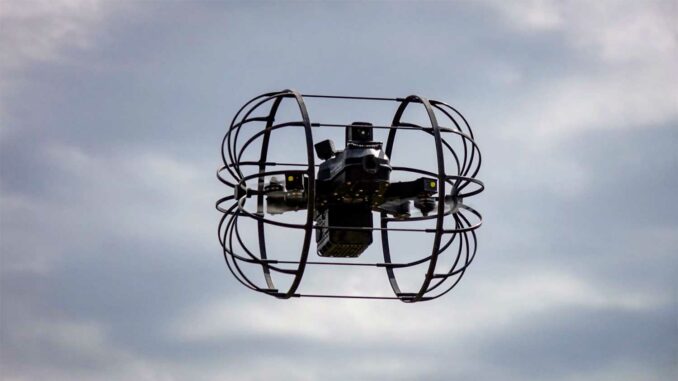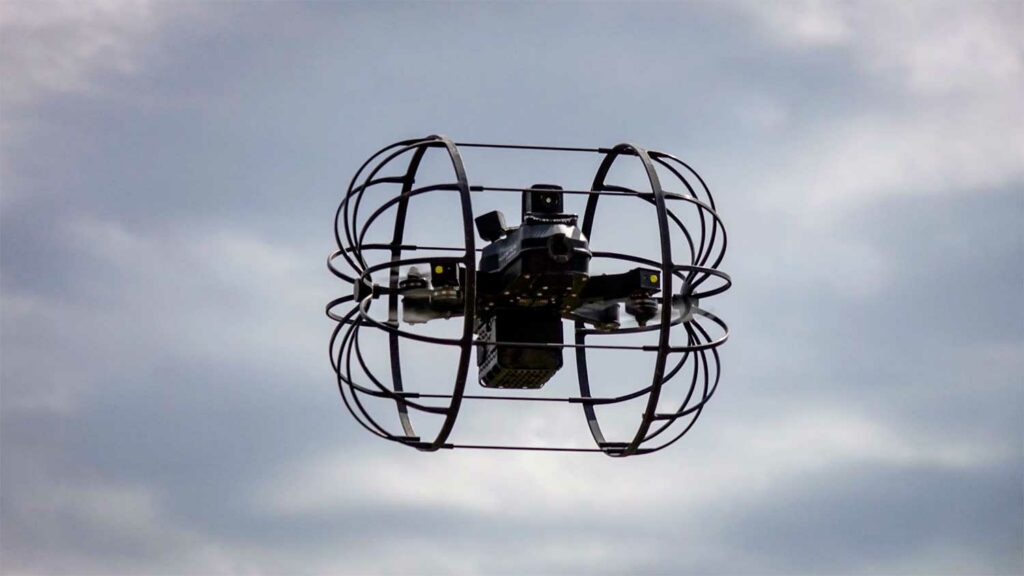
The ROOSTER tactical drone, a land-air hybrid, is entering service with European special forces after being registered by NATO.
The ROOSTER hybrid drone, designed by Israeli company Robotican, has been delivered to several special units in Europe. This tactical system combines flight and ground travel capabilities, enabling reconnaissance missions in confined, underground or degraded environments without relying on a GPS signal. Its lightweight structure, hybrid mobility, 90-minute autonomy, and day and night sensors offer a decisive operational advantage for intervention units. Officially registered by NATO, the ROOSTER is now deployed by Israeli, European, and US forces. It meets a growing need: to access tactical information in complex environments while reducing human exposure.
A hybrid system for missions in degraded areas
The ROOSTER is a hybrid tactical drone that combines the functions of a flying micro-drone and a rolling robot. This technological choice allows for optimal energy use, alternating between flight and rolling depending on the mission context. The configuration is particularly useful in enclosed or underground environments, where GPS signals are absent and flying in confined spaces becomes ineffective or dangerous.
The drone is enclosed in a spherical protective structure, which allows it to roll over uneven terrain or in ducts without risking damage to its sensors. It can thus infiltrate buildings, tunnels, or industrial areas that are inaccessible to conventional drones. This ground maneuverability is a concrete response to a well-documented challenge in urban operations: safe exploration without compromising the operator.
The drone is equipped with infrared cameras, visible and IR illuminators, and modular payloads, such as thermal cameras or hazardous substance sensors. Its operational range is suitable for urban search, industrial inspection, or CBRN response missions. It is not intended to replace conventional drones, but to complement existing capabilities in confined or fragmented environments.
Extended tactical autonomy and MESH interconnection
One of the critical issues with micro-drones is their limited autonomy. The ROOSTER has a standard mission duration of 90 minutes, with a passive autonomy of five hours in standby mode. This mode allows operations to be temporarily interrupted while maintaining the drone’s position in the environment to be monitored. This feature is essential for assault preparation or target surveillance prior to intervention scenarios.
The system is based on a MESH communication network, which allows coordination between up to three ROOSTER units without external infrastructure. This distributed network allows each drone to relay information to the operator, even in the event of a direct signal break. This technology is already used in military tactical communication systems, particularly for ground robots or digital radios deployed in mountainous or dense urban areas.
The use of this type of network allows units to simultaneously deploy several ROOSTERs in a complex structure (building, warehouse, shopping center, critical infrastructure) without risking losing contact with the operator. This improves the resilience of the device in the event of jamming, power outages, or the absence of GPS relays.

Operational integration validated by NATO
The ROOSTER has been officially registered by NATO, certifying its compatibility with Alliance standards. This NATO validation is a necessary step for the system to be listed in common logistics catalogs and used in joint exercises. It also means that ROOSTER has passed a series of technical tests on communications security, component robustness, and tactical interoperability.
This process is crucial for European special forces, which need to be able to quickly integrate new systems into their procedures without going through a lengthy adaptation phase. The drone is therefore already used by European intervention units, although the list of user countries has not been made public. However, it is known to be in service with the Israeli forces, certain US units, and now several European special groups operating in urban or sensitive contexts.
The NATO registration also makes it possible to finance the purchase of the system through inter-allied programs and to integrate ROOSTER into shared defense plans, particularly for operations in urban or underground areas (subways, logistics centers, port areas).
A direct response to the constraints of modern urban combat
Recent conflicts (Iraq, Syria, Ukraine) have shown that the urban environment remains one of the most complex for ground units, particularly in terms of reconnaissance and rapid decision-making. Conventional ISR systems (MALE drones, aerial sensors) are ineffective when forces have to penetrate compartmentalized structures without direct visibility. This is where ROOSTER comes into its own.
A concrete example: during an anti-terrorist operation in Europe, a quadcopter drone cannot enter a tunnel or inspect a basement. A conventional ground robot is slow and exposed. By changing mode (flight or ground mode), ROOSTER fills this tactical gap. It provides a view of the interior of a structure in a matter of minutes, without exposing a human operator. This time saving and increased safety are essential in the first few minutes of an intervention.
From a technical standpoint, its ability to operate without GPS, in low light, and with only one operator makes it a suitable tool for small units, often at the head of a column or on advanced reconnaissance missions. The fact that it fits in a backpack and can be deployed in less than 90 seconds adds to its immediate tactical value.
A European market with strong demand for lightweight hybrid systems
The success of ROOSTER is part of a clear trend among European armies to invest in compact, autonomous, and tactically flexible systems. The market for hybrid tactical drones is estimated at over $1.2 billion by 2030 in Europe, driven by demand from special forces, CBRN units, and internal security services.
Comparable systems such as the Flyability Elios 3 (Swiss) and the Skypersonic Skycopter (US) offer similar features but remain limited to the civilian or semi-military sphere. The ROOSTER stands out for its native military design, robustness, and validation by several armed forces. This combination puts Robotican in a strong position to conquer the NATO market, particularly in the segment of drones for confined environments.
Demand is growing with CBRN threats, operations against underground networks (trafficking, tunnels), and the security of critical infrastructure (ports, power plants, urban networks). The ROOSTER precisely meets these needs, while being operable by a single soldier without heavy logistics.
War Wings Daily is an independant magazine.